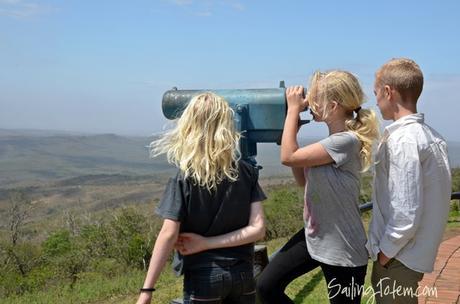
We dreamed about the iconic wildlife we’d have the chance to see in South Africa. But when we sketched out our plans to sail across the Indian Ocean, seeing them for ourselves in the vast parklands of South Africa felt dubious. Safari prices, at first blush, were well out of our reach. We’d be there in peak season, where choice lodging in choice parks are booked many, many months in advance. I wondered if we’d experience this facet of Africa.
Happily, I was mistaken about the cost and accessibility. Thanks to helpful insights from our friend Sue (of Ocelot fame- there’s a pile of info on their site) and a cockpit briefing from the Delos crew of places they’d visited, and within days of our arrival we were road-tripping our way to unforgettable encounters with wildlife.

Ty, our irrepressible crew, and his wife Nita rented a VW van to fit all seven of us and we took off on a two-day loop to parks/reserves within easy reach of where Totem lay in Richards Bay. The chance to see wildlife up-close was so exciting, I think I spent half of the time levitating. I might have squealed when we saw a clutch of hippos in the river on the way to meet up with our guide for a boat tour up the lower reaches of the iSimangaliso Wetlands Park. HIPPOS. Some kids like dinosaurs, some like elephants, this big kid has a thing for hippos.


From there we went inland to the Emdoneni Lodge; their cheetah rehab center cares for not just cheetahs, but servals, caracal (lynx), and African wildcats that have been injured or orphaned. It releases them to their habitat when possible, and acts as a home for cats that can’t be returned to the wild. It can be difficult to see these cats in the parks, so this gave us a chance for a close encounter accompanied with great information from our guide.

Our guide was well into his dialog on servals when one decided it was in love with Jamie’s feet. A minor complication: as he discovered, if you try to extricate your foot, the claws come out. Playful, but ouch!







Under Ty’s land-yacht captaincy we drove the roads of Hluhluwe-iMfolozi until the need to get back to Richards Bay in daylight pushed us along. One after another, the iconic big game of Africa sauntered by, or crested a hill in front of us, or flew past. It truly felt surreal.


Ty demonstrated a gift for manifesting. “I hope we can see a rhino,” he said, and BAM- trotting across the road in front of us, and right by the VW: a stunning (and terribly endangered) southern white rhino. We asked him if he’d take requests. There are nice lodges inside the park; they have security, and fences, but are still very much open to wildlife. Breaking for a meal at one of the lodges inside the park, we learned that a lion had taken down a wildebeest on their lawn just a few nights before. Sorry kids- no running around on the lodge’s soccer field! In the afternoon we picked up a couple of hitchhikers, two guys backpacking in Africa. Nate & Earl added great energy and sharp spotting eyes to our crew.

My lack of 12-month-advance planning to snag access to the big-name parks didn’t matter much at all, as it turns out. Self-driving into the parks was affordable and enjoyable; we could travel at our own pace, based on our own whims, instead of those of a larger group. Lodging was easy to get and affordable, since November is still a relatively slow month. We just had to get our brains unwrapped from the classic image of the glamping safari, get behind the wheel, and head into the savannah.

This post is syndicated on Sailfeed. Thanks for clicking through, it tosses change in our cruising kitty!

